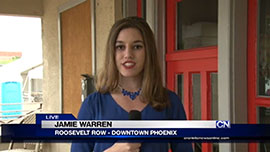Cronkite News has moved to a new home at cronkitenews.azpbs.org. Use this site to search archives from 2011 to May 2015. You can search the new site for current stories.
Protesters ask Phoenix officials to preserve Roosevelt Row culture
Some of the people who live, work and play in downtown Phoenix’s Roosevelt Row don’t like the direction the arts district is moving.
One developer plans to demolish GreenHaus Boutique and Gallery to make room for housing units. Another wants to tear down buildings on what’s known as the “Arts Market Block” for another residential project.
Projects like these – and other proposed developments – have ignited frustration with some members of the community. They plan to protest what they see as the death of the district’s “arts, culture, small business, street level activity, history and community,” according to the Facebook group organizing the event.
Protesters plan to meet at 5:30 p.m. on Thursday at 420 E. Roosevelt St. The goal: Voice their opposition to city leaders and developers.
The Facebook group “Save Roosevelt Row Symbolic Funeral Procession,” had more than 250 confirmed attendees as of Wednesday afternoon.
Adrian Fontes, a private practice attorney and former owner of Bodega 420, said the group fears for the district’s cultural death if cookie-cutter madness takes over.
Developer Wood Properties plans to tear down the office building that had housed Bodega 420, a small store, La Paz Taqueria, and use the plot of land between Third and Fifth streets that food trucks and vendors often use during events.
Fontes, an Arizona native and Phoenix local, said the Roosevelt Row community has worked hard to preserve what little history the area has by establishing a unique cultural and architectural heritage.
The neighborhood dates to the early 1900s, when some of the sidewalks were poured. The area began to decline in the 1970s, but experienced a revival in the late 1990s when artists began moving into the area, according to the Roosevelt Row Merchant Association’s website.
Fontes said community members established small businesses and built an evolving art scene, which made the area attractive to developers.
Locals welcome new property owners and developers, Fontes said, but they want those who preserve and support the culture.
“Bring it. But bring it well. Bring it intelligently. Bring it creatively,” Fontes said. “Don’t be lazy.”
Fontes said that if the city of Phoenix is going to promote Roosevelt Row as a tourism attraction, it should do its job to protect its postcard.
Roosevelt Row has garnered national attention for its arts scene. In fact, USA Today in May named the area as one of the 10-best arts districts in the country.
Michelle Dodds, Phoenix’s historic preservation officer, agreed that there’s a disconnect.
While the city encourages new residential developments in downtown Phoenix, this can be at the expense of older buildings locals want to preserve.
To promote preservation, Phoenix’s Planning and Development Department in 2008 began its adaptive-reuse program, which encourages business owners and developers to renovate existing buildings.
Even with the program, it’s difficult for the city to stop private deals and prevent developers from demolishing existing buildings, she said.
However, city officials can work with developers.
Baron Properties, which will develop housing units where GreenHaus Gallery sits on Roosevelt and Third streets, has worked with the city and community to preserve three of the building’s murals.
While Baron Properties could begin destruction any day, Fontes said the company wants to help preserve the murals and hold on to some of the city’s culture.










